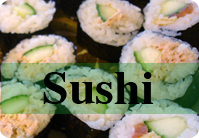Difference Between Sushi and Sashimi

If you happen to be a fan of the Japanese cuisine then you would come across the words sushi and sashimi very often and more often than not, you assume the two words to be synonyms. Though both sound very similar and also belong to the same country, there are still very subtle differences between the two preparations. This article aims at making the differences more clear to our readers.
In English, sashimi is often used to describe uncooked fish preparations. The original Japanese delicacy basically consists of different species of fish dipped in a mixture of wasabi and soy sauce that are sliced into thin pieces and then served raw. On the other hand, sushi essentially means vinegar rice that is topped up with countless varieties of additional ingredients, most popular of them being fresh raw fish.
Sashimi often constitutes the first course of an authentic Japanese meal though it can also be part of the main course, served with rice and Miso soup in two different dishes. It is a strong belief in Japan that sashimi, which is considered to be the finest preparation in the Japanese cuisine, should be served before stronger flavours are served. Culinarily, Sashimi very effectively emulates the appreciation of subtlety in the Japanese culture. The main ingredient, typically being sliced seafood, is enwrapped over white radish (daikon) which is shredded into long slim threads. Each slice of seafood is served with a shisho leaf. The main ingredient of sashimi is not necessarily a raw fish – it could also be a squid, shrimp or octopus. Owing to its chewy nature, sometimes octopus is served cooked rather than raw. Some uncommon sashimi preparations comprise sashimi made up of items like bean curd skin, chicken and even raw horse meat.
The traditional form of sushi consisted of rice and fermented fish which was preserved using salt. This process traces back to Southeast Asia where this preparation remains popular till date. The modern sushi bears little semblance to the older one. It is considered amongst the first fast food dishes. Unlike sashimi, sushi is known to exist in different forms; this difference is the result of use of different condiments, ingredients and fillings put together in different ways thus giving rise to different dishes. Different forms of sushi include Makizushi, Oshizushi, Inarizushi, Narezushi, western sushi etc. The popular form of sushi (western sushi) consists of rice rolls that are filled up with various fillings and are served with different sauces.
Since raw seafood forms a part of both preparations, the two delicacies carry some common health risks. Raw fish from fresh water is usually considered dangerous because of the threat of parasites. Fishes such as salmon are not eaten straight from the water as these tend to carry roundworm larvae that can be potentially dangerous to humans. Certain forms of sushi can lead to severe poisoning if not properly made. One way to avoid this is to freeze the seafood at sub zero temperatures to kill the parasites.
Leave your comments on this topic below.
- Difference Between Rival And Enemy - October 26, 2009
- Difference Between Xvid and H.264 - October 24, 2009
- Difference Between Obama and Bush foreign policy - October 23, 2009

Very helpful, thanks
Thank you.
My question was answered thoroughly.
Thx for a thorough answer to my question